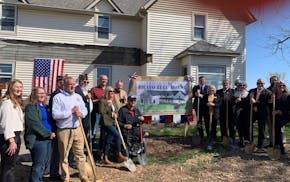For the first time in more than three decades, visitors to Nelson's Apple Farm in Webster, Minn., won't be able to pick their own apples this fall. That's because the crop has been so decimated that owner Ross Nelson will have to save his surviving apples for the farmer's market.
Instead, he and a few other growers are arranging to ship in fruit to sell at their orchards. "We'll be upfront about it," he said. "We'll still have wagon rides and a corn maze. Hopefully, our customers will continue to come."
This year's apple crop suffered "major damage" according to an update from the Minnesota Department of Agriculture. The damage occurred after a balmy March jump-started the bloom cycle, then freezing temperatures in April nipped the delicate blossoms at a critical stage.
Growers have held their breath for the last month, waiting for pollination to reveal more about the fate of this year's apple crop. Many had guessed, based on early blossom damage, that losses would be severe. Now that fruit has formed, damage reports vary widely, with some growers reporting only minimal losses and others, like Nelson, anticipating they'll be able to produce only a small fraction of last year's yields.
Consumers won't face a shortage of apples, but they may have a harder time finding their favorite locally grown varieties at farmer's markets. And much of the fruit in grocery stores will have to be shipped in from other growing regions, according to David Bedford, research scientist and apple breeder at the University of Minnesota.
"There are pockets of disaster," he said, "but overall, the state was not hurt as badly as we were first afraid."
Growers in those pockets are facing a bleak fall, however. Sweetland Orchard in Webster lost 80 to 90 percent of its crop, according to owner Mike Perbix. "It's not a total bust," he said, although he expects to reduce his pick-your-own season to a few weekends, and won't have enough fruit to produce cider.
Shefelbine Orchard and Pumpkin Patch near Holmen, Wis., was almost completely wiped out, according to owner Doug Shefelbine. "We have 30 acres, and if we get a bushel, we'll be lucky," he said. "I've been growing apples for 60 years, and it's the first time this has happened. They say it's a once-in-100 years event."
Shefelbine said he's encouraging other growers to report their losses, in hopes of having parts of the state declared a disaster area.
Southern Minnesota and Wisconsin growers were hit harder than northern ones because more of their trees were already in bloom when temperatures plunged, said Thaddeus McCamant, specialty crops instructor at Northland Community and Technical College in Detroit Lakes. He's been studying frost injury since 1989, and has spent the last month assessing orchards around the state.
"The damage wasn't as bad as people initially thought," he said, although "a significant minority" of orchards suffered major casualties. Damage was "spotty," he said, varying from location to location, within the same orchard and even the same tree.
"It's really weird," said Mike Dekarski, owner of Apple Jack Orchard in Delano and president of the Minnesota Apple Growers Association. Many of his trees, for example, are loaded with fruit at the top, but have none on the lower branches. "We'll have to do more work hand-thinning the crop," he said.
Some early-blooming apple breeds, such as Zestar!, were heavily damaged, Bedford said, while late-bloomers suffered little. Yields will be down for Honeycrisp, the state's most popular apple, but that's not due entirely to frost.
Honeycrisp is a biennial-bearing breed, producing high yields in alternate years. After a good crop in 2011, Honeycrisp trees statewide produced fewer blooms this year, he said. "You add frost to that, and we'll have a higher percentage of Honeycrisp from out of state."
Will imported Honeycrisps taste as good? "That's the question," Bedford said. Honeycrisp is a Minnesota-bred species, ideally suited to local growing conditions. "But even a poor Honeycrisp is better than the best Red Delicious."
The average last frost date has passed for much of the state, but growers are still crossing their fingers.
"I'm optimistic, but this is just the first hurdle of many," said John Jacobson, co-owner of Pine Tree Orchard in White Bear Lake, which hired a helicopter to churn the air over its trees one frosty April night.
"Now we've just gotta get through hail season," Dekarski said.
Kim Palmer • 612-673-4784

Protesters briefly clash at dual pro-Israel, pro-Palestinian rallies at the University of Minnesota

Defense attorneys in Feeding Our Future trial cast doubt on FBI's meal fraud investigation

Overdose deaths spike after incarceration, but Minnesota jails lack treatment

